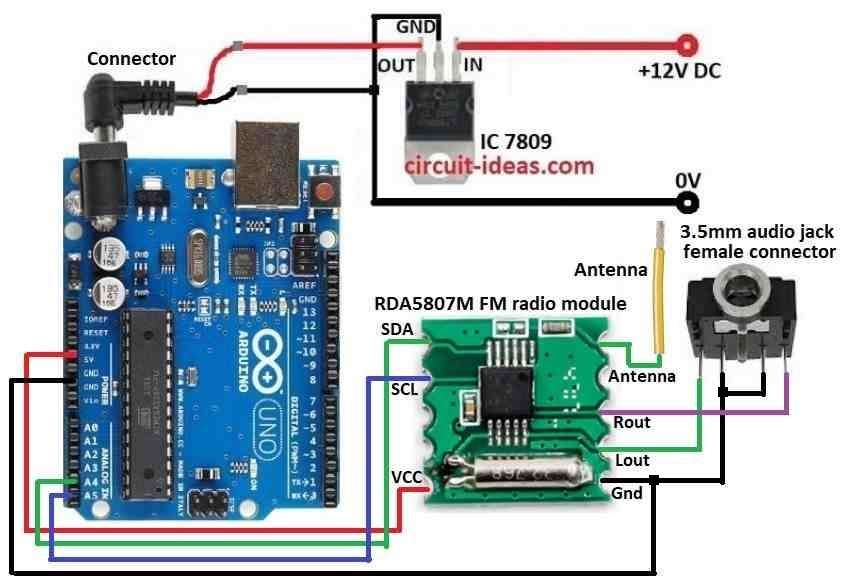This project uses Arduino Uno to make Simple Arduino FM Receiver Circuit.
Main part is RDA5807M FM radio module.
It get FM signal and changes to audio sound.
Sound goes through 7809 IC to make louder and then comes out from 3.5mm audio jack.
We can listen FM stations and learn basic digital electronics and radio waves.
Code:
#include <Wire.h>
#include <RDA5807M.h>
RDA5807M radio;
void setup() {
Serial.begin(9600);
Wire.begin(); // Initializes I2C communication on A4 (SDA) and A5 (SCL)
if (!radio.init()) {
Serial.println("RDA5807M initialization failed!");
while (1);
}
radio.setBandFrequency(RDA5807M::FM_BAND, 101.1); // Set to FM frequency 101.1 MHz
radio.setVolume(10); // Set volume (0-15)
}
void loop() {
// Update station or functionalities as needed
// For example, you could include buttons to change the frequency
delay(500);Code Explanation:
- Use two libraries RDA5807M for FM radio and Wire for I2C connection.
- Setup radio module and serial communication.
- Set volume and FM station to 101.1 MHz.
- Now volume and frequency stay same.
- But we can add buttons or knobs to change frequency later.
Circuit Working:

Parts List:
| Component | Quantity |
|---|---|
| Arduino Uno microcontroller | 1 |
| RDA5807M FM radio module | 1 |
| IC 7809 voltage regulator | 1 |
| 3.5mm audio jack female connector | 1 |
Circuit get 5V power from Arduino Uno.
RDA5807M module connect to Arduino digital pins for control and data.
FM signal come through antenna.
RDA5807M change FM signal to audio sound.
IC 7809 make audio louder.
Then sound goes to 3.5mm jack for speaker or headphone.
How to Build:
To build a Simple Arduino FM Receiver Circuit follow the below mentioned steps for connections:
- Take all parts like shown in circuit diagram.
- Use IC 7809 to give 9V DC to Arduino.
- Connect RDA5807M SDA to Arduino A4.
- Connect RDA5807M SCL to Arduino A5.
- Connect RDA5807M VCC to Arduino 5V.
- Connect antenna to Antenna pin on RDA5807M.
- Connect RDA5807M GND to Arduino GND.
- Audio jack first leg goes to Lout pin.
- Second and third leg goes to GND pin.
- Fourth leg goes to Rout pin.
Conclusion:
This Simple Arduino FM Receiver Circuit show how to join many parts to make working device.
We can change code to search more stations or add volume control.
By doing this we learn more about coding and electronics.
Keep trying and enjoy learning!
Leave a Reply